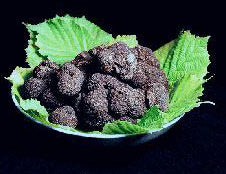 The French black truffle is the fruiting body of the fungus tuber melanosporum. This fungus forms a symbiotic relationship with the roots of oak and hazel trees. The edible portion, or truffle, is harvested in winter once it has matured.
The French black truffle is the fruiting body of the fungus tuber melanosporum. This fungus forms a symbiotic relationship with the roots of oak and hazel trees. The edible portion, or truffle, is harvested in winter once it has matured.
"The French black truffle is considered the finest of the edible fungi and has a place in gastronomy alongside saffron, caviar, foie gras and the finest of wines. Widely considered as the jewel of French cooking prized for its unique flavour and intoxicating aroma.
The use of the French black truffle is limited only by the imagination of the chef. It is used as a flavoring (similar to a herb) in a multitude of dishes such as, veal, soup, fish, shellfish, game, rice and salads.
"The fact is that the most valuable property of the French black truffle is its capacity to flavour with its perfume any dish which it's cooked in for some time."
Elizabeth David, Food Writer
The French black truffle has arrived from past grandeur. The ancient Greeks and Romans attributed therapeutic and aphrodisiac powers to them, qualities still in vogue last century. Brillat Savarin referred to them as "the jewel of cookery'" saying they aroused "erotic and gastronomic memories among the skirted sex, and memories gastronomic and erotic among the bearded sex" Alexandre Dumas described them as "the gastronomes holy of holies".
The French black truffle has a fresh shelf life of only three weeks, after which there is a rapid deterioration in quality. Each year in France, a proportion of the total production is processed; however executive French chefs will only cook with the fresh product. A French black truffle varies in size from 2 cm in diameter to the size of a grapefruit and is covered in black warts; its appearance indicates nothing of its true value.
The truffles are found from just below the soil surface to a depth of 20 cm. Specially trained dogs and pigs are used to search for the truffles. German research has found that the truffles contain a steroid similar to that which is produced by male pigs during pre-mating behaviour. This steroid acts as a pheromone, hence the attraction of female pigs.